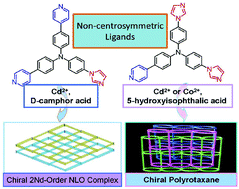Chiral coordination polymers have attracted much attention due to their special properties and significant applications. In this work, we synthesized two non-centrosymmetric ligands, N,N-bis(4-(1H-imidazol-1-yl)phenyl)-4-(pyridin-4-yl)aniline (DIMPPA) and N-(4-(1H-imidazol-1-yl)phenyl)-4-(pyridin-4-yl)-N-(4-(pyridin-4-yl)phenyl)aniline (MIDPPA), via structural modification of two reported centrosymmetric ligands; after that achiral → chiral induction occurred in the construction of three coordination polymers namely {[Cd(DIMPPA)(5-OH-bdc)](H2O)}n (1), {[Co(DIMPPA)(5-OH-bdc)](H2O)}n (2) and {[Cd2(MIDPPA)2(D-ca)2(H2O)2](H2O)5}n (3), when replacing the reported centrosymmetric ligands with non-centrosymmetric ligands (5-OH-H2bdc = 5-hydroxyisophthalic acid, D-H2ca = D-camphoric acid). Isostructural complexes 1 and 2 exhibit chiral 2D → 3D frameworks with the coexistence of polyrotaxane and parallel polycatenation features. Complex 3 shows two-fold interpenetrating 3D chiral architecture with cds-type topology. The luminescence emissions of both complexes 1 and 3 are mostly assignable to the internal π→π* electron transition in DIMPPA and MIDPPA, respectively. Complex 3 can satisfy the fundamental requirement of second-order nonlinear optical materials.
